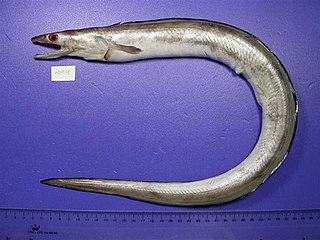
Anisakis is a genus of parasitic nematodes that have life cycles involving fish and marine mammals. They are infective to humans and cause anisakiasis. People who produce immunoglobulin E in response to this parasite may subsequently have an allergic reaction, including anaphylaxis, after eating fish infected with Anisakis species.

The Trichocephalida is an order of parasitic nematodes.

The dagger-tooth pike conger is a species of eel. They primarily live on soft bottoms in marine and brackish waters down to a depth of 800 m (2,600 ft), but may enter freshwater. They are common to about 1.5 m (4.9 ft) in length, but may grow as long as 2.2 m (7.2 ft). Dagger-tooth pike congers occur in the Red Sea, on the coast of the northern Indian Ocean, and in the West Pacific from Indochina to Japan. It has also invaded the Mediterranean through the Suez Canal.
Gnathostoma spinigerum is a parasitic nematode that causes gnathostomiasis in humans, also known as its clinical manifestations are creeping eruption, larva migrans, Yangtze edema, Choko-Fuschu Tua chid and wandering swelling. Gnathostomiasis in animals can be serious, and even fatal. The first described case of gnathostomiasis was in a young tiger that died in the London Zoo in 1835. The larval nematode is acquired by eating raw or undercooked fish and meat.
Xiphinema americanum is a species of plant pathogenic nematodes. It is one of many species that belongs to the genus Xiphinema. It was first described by N. A. Cobb in 1913, who found it on both sides of the United States on the roots of grass, corn, and citrus trees. Not only is Xiphinema americanum known to vector plant viruses, but also X. americanum has been referred to as "the most destructive plant parasitic nematode in America", and one of the four major nematode pests in the Southeastern United States.

Myrmeconema neotropicum is a tetradonematid nematode parasite.

The nematodes or roundworms constitute the phylum Nematoda, with plant-parasitic nematodes being known as eelworms. They are a diverse animal phylum inhabiting a broad range of environments. Taxonomically, they are classified along with insects and other moulting animals in the clade Ecdysozoa, and unlike flatworms, have tubular digestive systems with openings at both ends. Like tardigrades they have a reduced number of Hox genes, but as their sister phylum Nematomorpha has kept the ancestral protostome Hox genotype, it shows that the reduction has occurred within the nematode phylum.

Capillaria is a genus of nematodes in the family Capillariidae .

Like humans and other animals, fish suffer from diseases and parasites. Fish defences against disease are specific and non-specific. Non-specific defences include skin and scales, as well as the mucus layer secreted by the epidermis that traps microorganisms and inhibits their growth. If pathogens breach these defences, fish can develop inflammatory responses that increase the flow of blood to infected areas and deliver white blood cells that attempt to destroy the pathogens.
Gnathostoma hispidum is a nematode (roundworm) that infects many vertebrate animals including humans. Infection of Gnathostoma hispidum, like many species of Gnathostoma causes the disease gnathostomiasis due to the migration of immature worms in the tissues.

Clinostomum marginatum is a species of parasitic fluke. It is commonly called the "yellow grub". It is found in many freshwater fish in North America, and no fish so far is immune to this parasite. It is also found in frogs. Clinostomum marginatum can also be found in the mouth of aquatic birds such as herons and egrets. They are commonly present in the esophagus of fish-eating birds and reptiles. Eggs of these trematodes are shed in the feces of aquatic birds and released into water. Aquatic birds become hosts of this parasite by ingesting infected freshwater fish. The metacercariae are found right beneath the skin or in the muscles of host fish.

Huffmanela branchialis is a parasitic nematode It has been observed on the gills of the fork-tailed threadfin bream Nemipterus furcosus, a nemipterid marine fish off New Caledonia. Its eggs are released from the gill mucosa with the turnover of living tissues and immediately continue their life-cycle.

Huffmanela filamentosa is a parasitic nematode It has been observed on the gills of the lethrinid fish Gymnocranius oblongus and Gymnocranius grandoculis off New Caledonia. Its eggs are released from the gill mucosa with the turnover of living tissues and immediately continue their life-cycle.

Huffmanela ossicola is a parasitic nematode. It has been observed in the branchial arch bone and the spinal cord bone of the labrid marine fishes Bodianus loxozonus, Bodianus busellatus and Bodianus perditio caught off New Caledonia. This is the first species of Huffmanela reported from bone tissue. Its eggs are only available for the continuation of the life-cycle after the host's death.

Huffmanela is a genus of parasitic nematodes, belonging to the family Trichosomoididae.

The Trichosomoididae is a family of nematodes.

Huffmanela lata is a parasitic nematode. It has been observed on the skin of the grey reef shark Carcharhinus amblyrhynchos off New Caledonia. This species has only been reported once in the scientific literature.

Cucullanus austropacificus is a species of parasitic nematodes. It is an endoparasite of the fish Conger cinereus. The species has been described in 2018 by František Moravec & Jean-Lou Justine from material collected off New Caledonia in the South Pacific Ocean.
Cristitectus is a genus of parasitic nematodes, belonging to the family Cystidicolidae. Species of Cristitectus are parasitic as adults in the gastrointestinal tract of fish. According to the World Register of Marine Species, the genus currently (2019) includes a single species, Cristitectus congeri, which is a parasite of the European conger.

Contracaecum is genus of parasitic nematodes from the family Anisakidae. These nematodes are parasites of warm-blooded, fish eating animals, i.e. mammals and birds, as sexually mature adults. The eggs and the successive stages of their larvae use invertebrates and increasing size classes of fishes as intermediate hosts. It is the only genus in the family Anisakidae which can infect terrestrial, marine and freshwater animals.

















